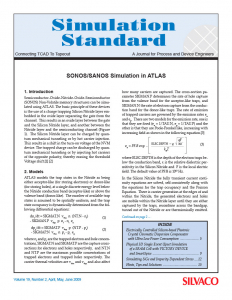SONOS/SANOS Simulation in ATLAS
1. Introduction
Semiconductor-Oxide-Nitride-Oxide-Semiconductor (SONOS) Non-Volatile memory structures can be simulated using ATLAS. The basic principle of these devices is the use of a charge trapping Silicon Nitride layer embedded in the oxide layer separating the gate from the channel. This results in an oxide layer between the gate and the Silicon Nitride layer, and another between the Nitride layer and the semiconducting channel (Figure 1). The Silicon Nitride layer can be charged by quantum mechanical tunneling or by hot carrier injection. This results in a shift in the turn-on voltage of the NVM device. The trapped charge can be discharged by quantum mechanical tunneling or by injecting hot carriers of the opposite polarity, thereby erasing the threshold Voltage shift.[1] [2]



